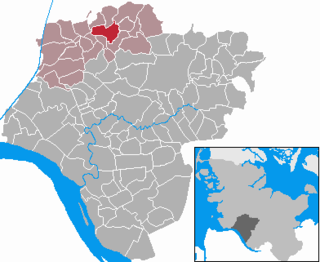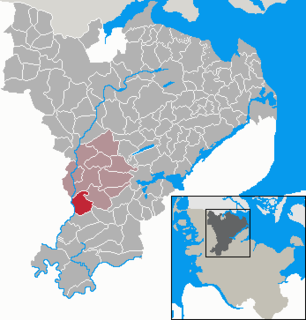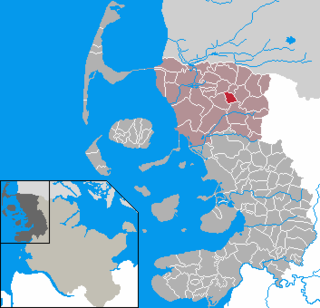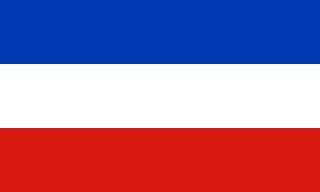
Schleswig is a town in the northeastern part of Schleswig-Holstein, Germany. It is the capital of the Kreis (district) Schleswig-Flensburg. It has a population of about 27,000, the main industries being leather and food processing. It takes its name from the Schlei, an inlet of the Baltic sea at the end of which it sits, and vik or vig which means “bay” in Old Norse and Danish. Schleswig or Slesvig therefore means “bay of the Schlei”.

Fehmarn is an island in the Baltic Sea, off the eastern coast of Schleswig-Holstein, Germany, and c. 18 kilometers south of the Danish island of Lolland. It belongs to the district of Ostholstein, Germany.

Steinburg is a district in Schleswig-Holstein, Germany. It is bounded by the districts of Dithmarschen, Rendsburg-Eckernförde, Segeberg and Pinneberg, and by the Elbe River.

Holstein is the region between the rivers Elbe and Eider. It is the southern half of Schleswig-Holstein, the northernmost state of Germany.

Friedrich Wilhelm, Duke of Schleswig-Holstein-Sonderburg-Glücksburg inherited the title of Duke of Schleswig-Holstein-Sonderburg-Beck in 1816. He subsequently changed his title to Duke of Schleswig-Holstein-Sonderburg-Glücksburg in 1825 and founded a line that includes the Royal Houses of Denmark, Greece, Norway, and the Commonwealth realms.

The First Schleswig War or Three Years' War was the first round of military conflict in southern Denmark and northern Germany rooted in the Schleswig-Holstein Question, contesting the issue of who should control the Duchies of Schleswig and Holstein. The war, which lasted from 1848 to 1851, also involved troops from Prussia and Sweden. Ultimately, under international pressure, the Prussians had to withdraw their forces. As a result, the war ended in a Danish victory over the rebels and the signing of the London Protocol in 1852. A second conflict, the Second Schleswig War, erupted in 1864.

The Second Schleswig War was the second military conflict over the Schleswig-Holstein Question of the nineteenth century. The war began on 1 February 1864, when Prussian forces crossed the border into Schleswig. Denmark fought the Kingdom of Prussia and the Austrian Empire. Like the First Schleswig War (1848–52), it was fought for control of the duchies of Holstein and Lauenburg, due to the succession disputes concerning them when the Danish king died without an heir acceptable to the German Confederation. Controversy arose due to the passing of the November Constitution, which integrated the Duchy of Schleswig into the Danish kingdom in violation of the London Protocol. Reasons for the war were the ethnic controversy in Schleswig and the co-existence of conflicting political systems within the Danish unitary state.

Fuhlsbüttel (help·info) is an urban quarter in the north of Hamburg, Germany in the Hamburg-Nord district. It is known as the site of Hamburg's international airport, and as the location of a prison which served as a concentration camp in the Nazi system of repression. As a result of boundary changes, JVA Fuhlsbüttel prison is now in Ohlsdorf, Hamburg.

Schenefeld is a municipality in the district of Steinburg, in Schleswig-Holstein, Germany. It is situated approximately 14 km north of Itzehoe.

Hollingstedt is a municipality in the district of Schleswig-Flensburg, in Schleswig-Holstein, Germany, located on the Treene river.

Tinningstedt is a municipality in the district of Nordfriesland, in Schleswig-Holstein, Germany. Most of the area is divided up into oddly shaped divisions of land. The area is primarily rural, with open country.

The Kiel–Flensburg railway is a single-track railway in Schleswig-Holstein, Germany. The railway connects the city of Kiel on the Baltic Sea with Eckernförde and Flensburg. Travel time over the 80 km (50 mi) railway is around 75 minutes with a maximum speed of 120 km/h (75 mph).

The Levensau High Bridge is a high level arch bridge that spans the Kiel Canal in the German state of Schleswig-Holstein. A second bridge nearby is referred to as Levensau Motorway Bridge.

The Denmark–Germany border is 68 kilometres (42 mi) long and separates Denmark and Germany.

The Eider Canal was an artificial waterway in southern Denmark which connected the North Sea with the Baltic Sea by way of the rivers Eider and Levensau. Constructed between 1777 and 1784, the Eider Canal was built to create a path for ships entering and exiting the Baltic that was shorter and less storm-prone than navigating around the Jutland peninsula. In the 1880s the canal was replaced by the enlarged Kiel Canal, which includes some of the Eider Canal's watercourse.

Godel is a river of the North Frisian island Föhr, Schleswig-Holstein, Germany.



















